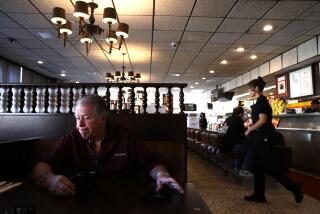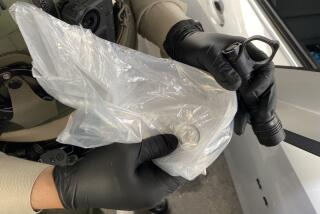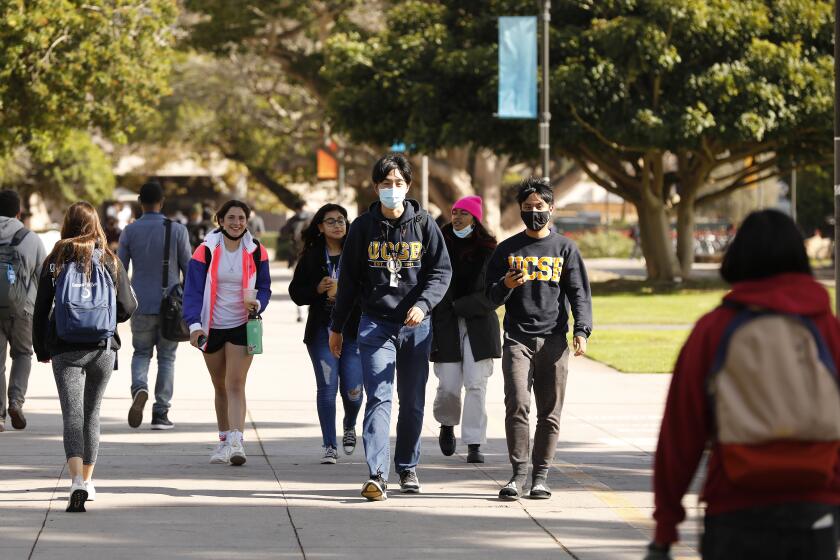Out for Blood: An Upstart Bank Hits Sensitive Vein : The Competition Is on for North County Donations
There is competition among auto manufacturers and competition among laundry detergents, but should there be competition among blood banks?
The Palomar-Pomerado Hospital District adopted that notion two years ago--striking out against the long-established San Diego Blood Bank and establishing its own laboratory, staff and recruiting drive to collect blood for use primarily at its two hospitals, one in Escondido and the other in Poway.
The bold move generated grumbling from within the ranks of the 38-year-old San Diego Blood Bank and confusion among blood donors who suddenly found themselves caught in a recruiting war between competing agencies who can only offer orange juice, T-shirts and other giveaway gimmicks--but not money--to win the good will of people to donate blood.
Escondido hospital officials say that, with two years’ operation under their belt, the Community Blood Bank has proven a success, even if it has not yet reached the break-even point financially for the district.
‘The Only Negative Word’
“The only negative word has come from the San Diego Blood Bank,” said Robert Edwards, executive director of the Palomar-Pomerado Hospital District. “It was easier for them to operate a monopoly, and now they don’t have that.”
San Diego Blood Bank officials say they still wonder what the Community Blood Bank is trying to accomplish, suggest there is nothing to be gained by duplicating what had been an effective countywide service, and go so far as to call the new blood bank “a disservice” to the county.
Because of the overlapping recruiting drives for blood donors, and confusion among the donors about where they should go--indeed, both blood banks operate donor centers in Escondido--”it’s getting more complicated and confusing,” said Nancy Harber, administrator of the San Diego Blood Bank. “So people are saying, ‘Forget it.’ They’re not donating at all. So it’s a disservice.”
Edwards said the district was prompted for several reasons to establish its own, in-house blood bank:
- There was concern that it would take an hour or longer, depending on traffic on Interstate 15, to deliver urgently needed blood from the San Diego Blood Bank’s depository on Upas Street in San Diego to the Palomar Medical Center, should the hospital’s on-hand supply not be sufficient to meet the needs of a major trauma case.
The Community Blood Bank is just a block away from the hospital, and can deliver large quantities of blood within minutes, should the need arise and assuming it has the correct type of blood on hand.
- Resentment that the San Diego Blood Bank changed its billing procedure and now charges hospitals, not the patient directly, for the cost of blood or blood components, thereby leaving it to the hospital’s own business office to collect the blood bill from the patient.
The San Diego Blood Bank succeeded in unburdening itself of bad debts, leaving the hospital holding the liability of trying to collect from patients who might not make good.
- A belief that the district could provide blood for its patients more cheaply than by buying it from the San Diego Blood Bank. That issue is especially relevant with Medicare patients, because the state reimburses the hospital a straight fee to provide the necessary medical care based on the specific type of diagnosis versus the actual cost of the care provided. In such cases, the hospital has to absorb any costs--including blood--that might exceed the Medicare reimbursement. If it can generate blood more cheaply in-house, the hospital saves money.
Edwards concedes that he hasn’t figured out the actual direct and indirect costs to the district--in salaries, facility overhead, advertising, laboratory and the like--for processing the blood. But the district will charge a patient $68.50 for a pint, or unit, of red cells; the San Diego Blood Bank charges $69.00.
- A desire to tap community spirit because of the notion that local residents will be more willing to donate blood if it is more likely to be used locally, by friends, neighbors and fellow townsfolk, rather than by strangers in, say, Chula Vista or El Cajon.
“A lot of people think, ‘Gee, I live up here. I might get hurt or my kids might get hurt and need blood, and I want to make sure I’m giving blood to my local community,” said Alain Jordier, who heads the three-person community relations--or recruiting--office of the Community Blood Bank.
But Lynn Stedd, who heads a staff of eight in the community relations office of the San Diego Blood Bank, says altruism in donating blood should not be limited to community boundaries.
“The most efficient blood banking systems are those that have a centralized inventory which they can rotate among hospitals and ensure the proper types are available wherever they’re needed,” she said.
Larger Population Base
“If a whole bunch of people living in El Cajon donate O-positive and an accident occurs in Escondido and O-positive is needed, we can accommodate that. We are drawing from a larger population base and are able to meet the needs for blood, wherever they are.”
She argues, too, that hospital district residents receive their care not just at Palomar Medical Center in Escondido and Pomerado Hospital in Poway, but at Children’s Hospital in San Diego, if they are children in need of specialized care, and at the UCSD Medical Center if they are burn victims.
Competing blood banks serving the same metropolitan area are unusual, officials say. In the few instances where they occur--such as in the Miami-Ft. Lauderdale region of Florida--they usually are the result of an established blood bank encroaching upon the service area of a neighboring region’s established blood bank.
Los Angeles and Orange counties’ blood-banking needs are provided by the American Red Cross, which operates a central processing laboratory to serve both counties’ hospitals, said Tom Schallert, associate administrator for blood services for the Red Cross.
“Some hospitals draw their own blood, usually in blood drives involving their own employees, or from the families of patients,” he said. “But they don’t go out into the community to recruit.
“Not too many places have the kind of competition that exists in San Diego County,” he said. “They usually worry about the impression it creates on donors . . . who don’t understand why two nonprofit organizations would be competing for blood donors.”
What effect the Community Blood Bank has had in the amount of blood being donated countywide is unclear.
Dr. Jerry Kolins, a pathologist who is the medical director of the Community Blood Bank, suggests that, if anything, the Escondido operation has increased the amount of blood donated countywide.
He said San Diego County in 1988 led all the counties in the state for increases in blood donations--13% more blood was donated here in 1988 than in 1987. Most counties showed blood donation increases of only 2% or 3%, and some even received less donated blood than the previous year, he said.
Location of Increase
Stedd said that, although she doesn’t discount that report, “if we were to break down where those increases occurred within the county, it would indicate they were not in inland North County.” She noted, for instance, that her blood bank opened a new donor center next to Tri-City Medical Center in Oceanside.
But Stedd’s own figures indicate that the San Diego Blood Bank can’t take credit for the countywide blood donation increase.
The San Diego Blood Bank collected 87,600 pints of blood in the fiscal year ending June 30, 1986; 96,183 pints in the year ending June 30, 1987, and 95,267 pints in the year ending last June 30--a drop from the previous year, and the first full reporting year reflecting the competition between it and the Community Blood Bank.
At its Escondido donor center, the San Diego Blood Bank collected 9,903 pints of blood in fiscal year 1986, 10,156 pints of blood in fiscal year 1987 and 8,789 pints last year.
Stedd said the drop in donations at the Escondido donor center from 1987 to 1988 can be attributed largely to the opening of the blood donor center in the Tri-City area, from where donors previously had traveled to Escondido.
In contrast, the Community Blood Bank, which opened in December of 1986, has collected about 15,000 pints of blood since opening, said Kolins--less than has the San Diego Blood Bank’s donor center in Escondido during the same period.
However, last month, the Community Blood Bank mounted an intense recruiting drive and generated 1,155 pints of blood, while the San Diego Blood Bank received 962 pints at its Escondido donor center.
December was only the second month, Kolins said, that the Community Blood Bank collected more than 950 pints--considered the break-even point in order to meet set costs such as salaries, equipment and laboratory testing. The blood bank, he said, operates on an annual expense budget of about $1 million, with income about 85% of that.
Dispute Over Figures
It would seem clear from the figures that, combined, the San Diego and Community blood banks generated more blood countywide than the San Diego Blood Bank had on its own before the Community Blood Bank arrived on the scene.
But Stedd suggests the higher figure also represents growth in the region--a great number of donors to be tapped. Furthermore, she suggests that even more donors would have come forward last year if there was just one recruiting agency in the county--hers--so as not to confuse potential donors.
The debate continues:
Kolins said that, over the past three months, the Community Blood Bank was able to provide “100% of the blood needs for Pomerado Hospital, and 98% of the blood needs for Palomar Medical Center.” In fact, the blood bank at times had enough of a surplus to sell blood to Tri-City Hospital and a hospital in Los Angeles.
Stedd counters that, during 1988, the San Diego Blood Bank was called upon to provide 472 pints of blood to Pomerado Hospital and about 2,000 pints to Palomar Medical Center, despite the presence of the hospital’s own in-house blood bank.
Dr. David Cloyd, chairman of the trauma department at Palomar Medical Center, said fellow surgeons are especially pleased by the presence of the Community Blood Bank a block away. Among other benefits, he said, it can quickly supply blood platelets--a coagulating component of blood that is especially critical for patients who have experienced a major loss of blood, and which are not routinely put in hospital inventories by the San Diego Blood Bank because they are in relatively short supply and can only be doled out as needed.
‘Marked Improvement’
“There are many times in the past when I’ve had to wait in the operating room for blood components to come from San Diego,” Cloyd said. “Since the Community Blood Bank opened, there’s been a marked improvement.”
Nonetheless, “just last week we had to send 66 units of platelets to Palomar,” counters San Diego Blood Bank’s Stedd.
There is bad blood, too, over recruiting methods.
- Stedd said her office learned that the Community Blood Bank’s sole bloodmobile was seen in Mira Mesa, outside of the district’s boundary, in a donation drive.
The bloodmobile was there, Community Blood Bank officials respond, because of a specific blood donation campaign orchestrated to help a patient at one of its own hospitals.
Besides, they say, doesn’t the San Diego Blood Bank bloodmobile still ply the parking lots of Escondido?
- Shortly after the Community Blood Bank opened, it placed a newspaper advertisement featuring the thank-you of a patient who credited the blood bank for helping save her life.
But the San Diego Blood Bank did some homework, and countered that it had supplied most of the blood used by that patient.
- “We understood from the very beginning that the Community Blood Bank was not intending to contact the same groups we currently work with, and have a long history with, in blood drives,” said Stedd. “But they are systematically contacting all the groups we already work with.”
Indeed--and often the battlefront is in Rancho Bernardo, a prime recruiting area with its office parks.
NCR Corp., like others, had long organized blood drives in cooperation with the San Diego Blood Bank, only to be hit up by the Community Blood Bank.
“After much investigation and looking at the people we’ve been working with, we felt it would be better to stay with the San Diego Blood Bank,” said an employee of the company’s medical office who asked not to be identified. “Since we have employees from all over the San Diego area, and since apparently the San Diego Blood Bank is still providing blood to Palomar and Pomerado, management decided to stay with it.”
From 1 to 2 Blood Drives
Hewlett-Packard Co. took a different approach.
“We went from one blood drive a year to two,” said occupational health nurse Kathy Bryan. Last year, the San Diego Blood Bank received its customary 150 to 175 pints of blood from Hewlett-Packard employees; the Community Blood Bank, on its visit, received 70 pints. The difference, Bryan said, didn’t reflect a popularity vote between the two agencies but rather a smaller Community Blood Bank staff to wield the needles.
Hospitals around the county generally will accept blood from either blood bank--especially if blood is donated at one center or another and is directed to a specific patient at that hospital, with the doctor’s approval. But there is even confusion among hospital staffs if a person asks where he should donate blood on behalf of a patient at that hospital.
A lab worker at Tri-City Medical Center said, without hesitation, that blood could be donated at either of the two blood banks if it were being directed to a patient there.
‘Honestly, I Don’t Know’
At Children’s Hospital, a lab technician responded to the question of where a donor should go by saying, “Honestly, I don’t know.”
And at Mercy Hospital, a lab worker said she preferred the donor go to the San Diego Blood Bank. “You can go to the Community Blood Bank, but it’s an awful lot more complicated,” she said.
Outside of the Escondido areas, doctors might not very much care where their blood supplies originate. “I suspect blood is probably thought of as a supply item, and I’m not sure a physician will think in terms of needing blood from one blood bank or the other,” said David Knetzer, executive director of the San Diego County Medical Society. “This is a subject that has not come up at any medical society committee meetings.
“The San Diego Blood Bank is so established, trying to run its operation in an efficient way, they would like to be the only game in town,” he said. “I’m not sure that’s all bad, to be the only game in town.
“The Community Blood Bank gives the hospital district something others don’t have--a new service. But I don’t think that makes them any more competitive,” he said.
Stedd, at the San Diego County Blood Bank, said she would like to see the issue of the competing blood banks resolved.
“We don’t want to make matters worse than they are,” she said. She noted that her office learned of the Community Blood Bank’s start-up by reading the newspaper instead of through a courtesy call.
“I’d welcome an understanding of why this situation occurred in the first place,” Stedd said. “Maybe that would help us figure out how we can resolve this.”
Edwards, the hospital administrator, said the district has no second thoughts about its commitment.
“Since we’ve been in business, there’s been an increase in the blood supply in greater San Diego County. We haven’t hurt the county a bit,” Edwards said.
More to Read
Sign up for Essential California
The most important California stories and recommendations in your inbox every morning.
You may occasionally receive promotional content from the Los Angeles Times.





